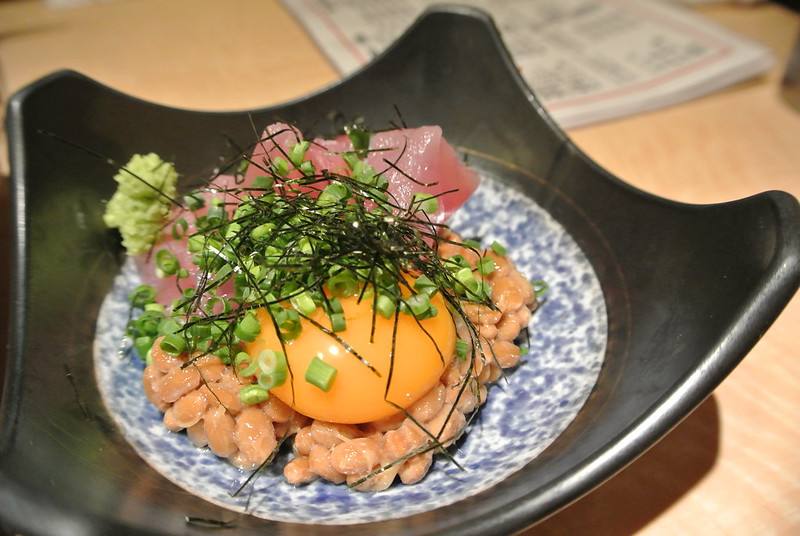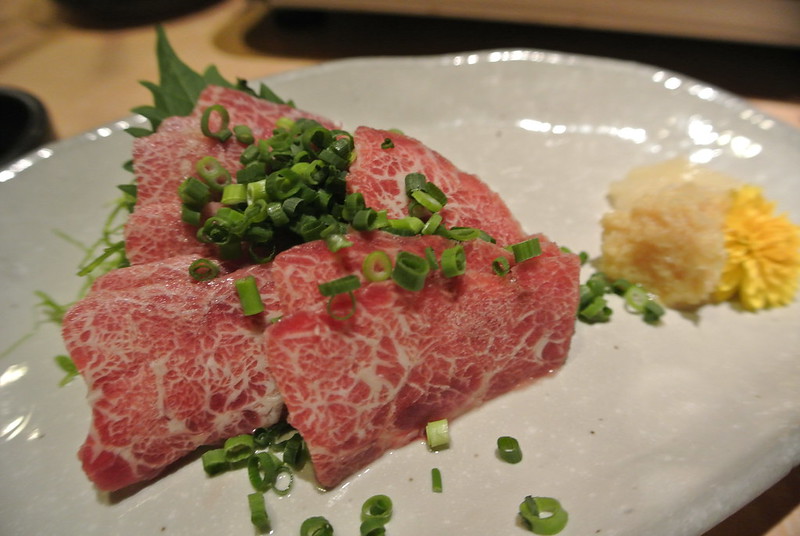Tokyo raw foods: sashimi and sushi
Now that I'm feeling better, lets talk about something both microbes and I live on: raw foods. Japanese cuisine consists of a wider range of raw foods than most cultures that I am familiar with, and I can tell you that it was quite jarring eating raw fish or meats for several meals in a row. It could have been all mental, but my stomach was working hard to tolerate all of it.
 |
| Tuna and salmon roe maki at Tsujiki fish market |
Of course I visited the Tsujiki fish market when I was in Tokyo. I didn't make it to the auctions (tourist fail), but I was still able to snag a space at the limited seating inside a cozy sushi bar in the market. I did a set meal where the chef offered the seasonal specials and put it on your platter piece by piece as he finished preparing them. Though the fish were more roughly cut and larger sized than I expected, all of them were extremely fresh and buttery. I'm salivating just thinking about it!
Later that day, my Japanese tour guide Fukuko and I went to a chanko nabe restaurant. She ordered a side dish that was composed of natto, raw tuna, a raw egg, raw scallions, and seaweed shreds. She warned me that I would probably not like the distinct pungent flavor, but I should give it a try anyways because it's something she grew up on. Natto is not a raw food, for it is fermented soybeans with Bacillus subtilis, which has probiotic qualities. I'm writing about it here because it was served with two very raw things. Fukuko was right to warn me, for there was a very strong and sweet bean flavor, it was sticky and slimy, and it was really like nothing I've had before besides honeyed soybeans at some Chinese restaurants. Even then, the natto's flavor was quite overpowering, and I'm glad it was paired with the tuna for texture and taste.
At that same meal, we also had basashi, horse sashimi. This was something that I was told to try, but I wasn't that sold on. But Fukuko ordered it, so I was down to try it. The basashi arrived frozen. It was a plate of thinly sliced horse meat. It's served with mashed daikon and soy sauce, but because of quality and contamination reasons, it is also served frozen. The horse meat had a distinct flavor that I can't quite put my tongue on (a bit gamey, a bit like rabbit), but the texture was similar to any other frozen red meat that you might have ever had. What surprised me was the texture of the meat. It was so finely marbled with fat! Are all horses that fat? No way, It must be specially raised horses for eating. Anyways, I don't think I'd go out of my way to eat it again, but it was worth a try!
Now, my favorite new thing that I tried during my short stay in Tokyo was toriwasa, chicken sashimi. We went to a yakitori joint in the neighborhood Fukuko grew up, and along with a set of skewers of all different chicken parts, my lovely local guide ordered chicken sashimi. I know, you must be cringing by now. First horse, now chicken? Why not throw some raw pork in there? Relax, I definitely did not eat raw pork, and I was extremely skeptical about eating raw chicken. However, after the first bite, I was infatuated. I couldn't stop. The every so slightly seared bits of raw chicken coated in a fresh wasabi sauce was so succulent and flavorful, that I totally disregarded that no one west of Japan eats raw chicken. Please do not try making this at home. I'm certain that you will contract a lot of bacterial infections if you do this with conventional American grown chickens. But hey, if people are actively eating raw chicken in this foreign country, then so will I.
Raw foods is not for everyone, but I must say I have a soft spot for everything raw, and Tokyo was the perfect place to fulfill it.
 |
| SUSHI and tamago |
 |
| Natto, tuna, and a raw egg |
 |
| Basashi, horse sashimi |
 |
| Tariwasa, chicken sashimi |